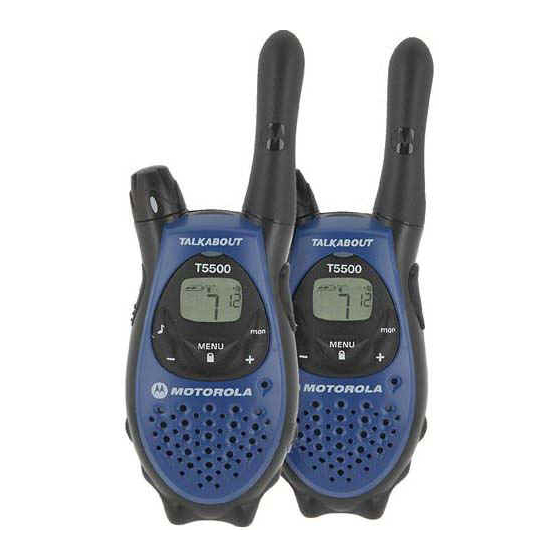Motorola TALKABOUT T5500 Посібник з комунікацій - Сторінка 11
Переглянути онлайн або завантажити pdf Посібник з комунікацій для Радіо Motorola TALKABOUT T5500. Motorola TALKABOUT T5500 16 сторінок. Frs/gmrs recreational two-way radios
Також для Motorola TALKABOUT T5500: Посібник користувача (36 сторінок), Посібник користувача (17 сторінок), Посібник користувача (5 сторінок)

• If copying (understanding) the transmissions is difficult spell out words by
using a phonetic alphabet as mentioned above.
• When you are talking on the same channel at the same time as another person
it is called "doubling". Sometimes it is because the person you are speaking
to thinks that it is their turn to transmit and, not only doesn't know you are
also transmitting, but thinks you are hearing what they are saying. To let the
person know it is now their turn to talk say "over" or "go ahead" at the end of
each transmission.
• In communications involving more than two stations always indicate who
should transmit next by saying "go ahead Communications Center" or "over
to you Search Team Alpha".
• When concluding a series of transmissions say "out" or "clear"
4) Radio jargon
There are some commonly used words while talking on any kind of two-way radio.
Some are so well known by the public (and most make good sense) that we will use
them in our CERT work. However, we should avoid using the 10-codes (like 10-4)
because many people do not know them. The radio terms we will use are:
• "Over" which means "I am done with my transmission, you go ahead and start
talking now". Sometimes one substitutes "go ahead" "go" or "take it" for "over"
for variety.
• "I copy" or "I read you" means "I heard you and I understood all of it". If you
missed part say so.
"Roger" means "Yes, I agree"
•
• "Stand-by" means "please wait and do not transmit until I tell you to". The reply
should be "standing by".
5) Coordinating speech with the PTT (push-to-talk) or "Talk"button
One of the commonest errors in two-way radio is clipping off the first or last word of
a transmission because of incorrect use of the PTT button. It is essential to learn to
consciously wait two seconds before you begin talking after pushing the PTT button.
Similarly, at the end of your transmission always remember to stop talking and then
wait two seconds before letting up on the PTT button
HOW TO GET THE MOST OUT OF YOUR FRS RADIO
1) Line-of sight
In order to make these radios work efficiently you must pay attention to this section.
We believe that it may be the most important in this manual. Radio transmissions
using UHF* frequencies travel by what is called "line-of-sight". That means that if
you can see the person you want to talk to your radio will probably work. However,
if something is in the way the signal will drop off or disappear. Things like hills,
buildings, metal objects, dense foliage, and the curvature of the earth are
For disaster communication in the ASNC area, tune to FRS Channel 2 (Alternate: Ch 12)
Ham Radio Operators should also tune to Battalion 2 simplex 145.585 MHz, PL 110.9
11
